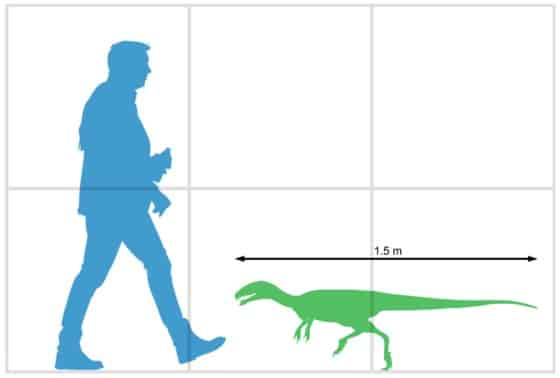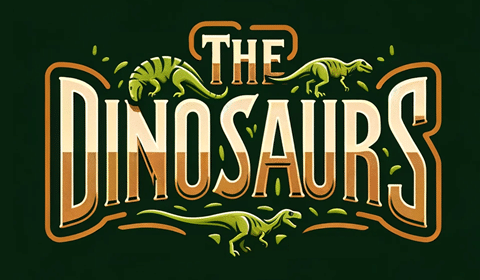Unearth the mysteries of Noasaurus–a fascinating theropod dinosaur from the Late Cretaceous period. This carnivore dino, whose name translates to “Northwestern Argentina Dinosaur,” roamed the Earth over 70 million years ago. Discover its unique characteristics, intriguing history, and the significant role it played in the prehistoric world.
Today, we’re going to embark on a journey back in time to an era when this captivating theropod dinosaur roamed the Earth. Noasaurus is a fascinating subject of study for anyone interested in paleontology. It is known from only a single partial skeleton. However, we have still been able to learn much about this dinosaur. So, come along and explore the world of Noasaurus.
Noasaurus Key Facts
| Keyword | Fact |
|---|---|
| Noasaurus pronunciation | NOH-ah-SAWR-us |
| Meaning of name | Northwestern Argentina lizard |
| Group | Theropod |
| Type Species | Noasaurus leali |
| Diet | Carnivore |
| When it Lived | 70.6 to 66.0 MYA |
| Period | Late Cretaceous |
| Epoch | Early/Lower Maastrichtian |
| Length | 5-6.5 ft |
| Height | 1-2 ft |
| Weight | 30-35 lbs |
| Mobility | Moved on two legs |
| First Discovery | Mid 1970 by Jaime Eduardo Powell and José Fernando Bonaparte |
| Location of first find | Estancia El Brete, Argentina |
| First Described by | 1980 by Jaime Eduardo Powell and José Fernando Bonaparte |
| Holotype | PVL 4061 |
Noasaurus Taxonomy and Timeline

Noasaurus is a simply named dinosaur. It gets its name from the region it was first discovered in–Northwestern Argentina. The name is a combination of ‘NOA’, an abbreviation for Northwestern Argentina, and ‘sauros’, the Greek word for reptile or lizard.
It is a member of the Theropoda group, a classification that includes some of the most well-known dinosaurs such as the mighty T-Rex. Within this group, it belongs to the Noasauridae family and is the type species for Noasaurus genus. This species, Noasaurus leali, is the only species in the genus.
This fascinating dinosaur lived during the Late Cretaceous period, specifically during the Early/Lower Maastrichtian epoch. This places it in the time leading up to the mass extinction of non-avian dinosaurs 66 million years ago.
Listen to Pronunciation
Discovery & Fossil Evidence
The story of this discovery is as intriguing as the dinosaur itself. In the mid-1970s, a fragmentary small theropod skeleton was unearthed at the Estancia El Brete site in Argentina. This initial find was made by Jaime Eduardo Powell and José Fernando Bonaparte. The discovery was reported in scientific literature in 1977 and the Noasaurus leali was officially named and described by Bonaparte and Powell in 1980.

The holotype, designated PVL 4061, was found in a layer of the Lecho Formation in Salta Province, Argentina. This partial skeleton consists of pieces of a skull, some vertebrae, two neck ribs, two hand claws, a finger phalanx, and the second right metatarsal bone. Interestingly, one of the hand claws was initially identified as a second toe claw. However, in 2004, it was recognized as a hand claw–leading to the referral of the second hand claw. This discovery was a significant development in our understanding of the Noasaurus and its physical characteristics.
In 1999, a neck vertebra found at the site was identified as oviraptorosaurian, a rare proof that the Oviraptorosauria had invaded the Gondwanan continents. However, in 2007, it was reidentified as a noasaurid vertebra that probably belonged to this Noasaurus holotype. This reidentification further solidified Noasaurus‘ place within the Noasauridae family.
Noasaurus Size and Description
Noasaurus was a small theropod–a group of dinosaurs known for their bipedal stance and carnivorous diet. Its unique features and intriguing history make it a fascinating subject of study for paleontologists and dinosaur enthusiasts alike.
Despite its small size, this was a creature of notable characteristics. Its body shape was typical of theropods, with a bipedal stance and a long, flexible tail for balance. The head was likely small and equipped with sharp teeth suitable for its carnivorous diet. Its neck was probably long, as suggested by the elongated neck vertebrae found among the fossil remains.
The limbs of Noasaurus were adapted for a life of predation. The hand claws were initially mistaken for toe claws. These claws were likely used for hunting and capturing prey.
Size and Weight of Type Species

Estimating the size and weight is a bit of a challenge due to the fragmentary nature of the fossil remains. However, based on the available evidence, it’s estimated that this dinosaur was about 5-6 feet in length and weighed around 30-35 lbs. Based on the length and mass, it was likely around 12-24 inches high at the back. This makes it one of the smaller theropods, but no less fascinating for its size.
The Dinosaur in Detail
Taking a closer look at Noasaurus, one of its most distinctive features was its hand claws. These claws were exceptionally curved and uniquely shaped, with parallel base sides in top view and a deep triangular cavity at the base underside. This unique feature was initially mistaken for a toe claw, but later research confirmed its correct placement on the hand.
It also had a long neck, as suggested by the elongated neck vertebrae found among the fossil remains. These vertebrae were strongly vertically compressed with a low neural spine and bore long bony projections, a typical trait for its relatives. This long neck likely gave this dinosaur a greater reach when hunting for prey.
Noasaurus is the type genus of the Noasauridae family, a side group of theropod dinosaurs that are thought to have had the same immediate origins as the abelisaurids. This connection to the Abelisauridae family, a group of dinosaurs known for their short snouts and horned skulls, provides interesting insights into the evolution and diversity of theropod dinosaurs.
Noasaurus in its Natural Habitat
This carnivorous dinosaur lived in what is now Northwestern Argentina. This region is known for its diverse geography and climate throughout the past. During the Late Cretaceous period, this area was likely a mix of forests and open plains that provided a suitable environment for a variety of plant and animal life. The climate was likely warm and humid, similar to today’s tropical regions.
As a carnivore, this dinosaur would have been a predator or scavenger that fed on smaller animals and possibly the young of larger dinosaurs. Both its sharp teeth and curved hand claws would have been useful tools for capturing and killing prey. Its bipedal stance and long tail would have provided balance and agility–essential traits for a predator.
Like other theropods, it was likely a solitary hunter. However, it’s also possible that they may have hunted in small groups, similar to some modern-day carnivores. While we can’t be certain about the Noasaurus’ senses, it’s likely that it was similar to other theropods and had keen vision and a strong sense of smell to detect prey and avoid predators.
Interesting Points about Noasaurus
- This is the type genus of the Noasauridae family. This group of theropod dinosaurs are thought to have shared common origins with the Abelisaurids.
- The hand claws were initially mistaken for toe claws. This misunderstanding was later corrected, leading to a better understanding of the dinosaur’s physical structure and hunting methods.
- The name, which translates to “Northwestern Argentina lizard,” reflects the region where it was first discovered.
- Despite the fragmentary nature of the fossil remains, researchers have been able to glean significant insights into the dinosaur’s physical characteristics and lifestyle.
- The discovery of this small carnivore has contributed to our understanding of the diversity and evolution of theropod dinosaurs.
Contemporary Dinosaurs
Noasaurus shared its world with a great number of contemporaries. Among others, they included both Saltasaurus and Aucasaurus as well as Carnotaurus. Each contributing to the intricate symphony of existence that played out in this ancient era.
Saltasaurus was an herbivore, a stark contrast to the carnivore Noasaurus. Its size and its armored skin were a natural defense against predators that would have made it a challenging target. Yet, the possibility of a hunt cannot be entirely dismissed, as Noasaurus was known for its agility and cunning. This dynamic between the two may have led to thrilling chases–a testament to the relentless struggle for survival that defined their era.
On the other hand, Aucasaurus and Carnotaurus were both predators like Noasaurus that might have been competitors rather than prey. These carnivores, each formidable in their own right, could have vied with Noasaurus for the same food sources. This intricate interplay of competition adds another layer of complexity to the narrative of Noasaurus, further emphasizing its role in the vibrant ecosystem it inhabited.
List Of All Dinosaurs
We have created a list of all dinosaurs we have covered here, sorted across the seven main groups of dinosaurs. We also include information about their type of diet, (omnivore, herbivore or carnivore) and the time they lived.
Frequently Asked Questions
The name translates to ‘Northwestern Argentina lizard’. It’s derived from NOA, an abbreviation for Northwestern Argentina, and the Greek word ‘sauros’, meaning reptile or lizard.
As a member of the Theropoda group, the Noasaurus was a carnivore that preyed on other creatures for sustenance.
This intriguing creature lived during the Late Cretaceous period, specifically in the Early/Lower Maastrichtian epoch, around 70.6-66 million years ago.
The Noasaurus is part of the Noasauridae family, a group of small to medium-sized carnivorous theropods.
It was first described by Jaime Eduardo Powell and José Fernando Bonaparte in 1980, based on the holotype PVL 4061.
Sources
Please note that the information in this article is based on various sources, drawing on scientific research, fossil evidence, and expert analysis. The aim is to provide a comprehensive and accurate overview of the Noasaurus, but please be aware that our understanding of dinosaurs and their world is constantly evolving as new discoveries are made.
Article last fact-checked: Joey Arboleda, 06-12-2023
Featured Image Credit: Debivort, CC BY-SA 3.0, via Wikimedia Commons
